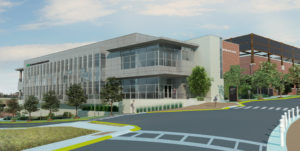Expanding Technological Efficiency at the UAB Technology and Innovation Center.
The University of Alabama Birmingham (UAB) wanted to develop a state-of-the-art data facility to replace their aging center. UAB also wanted the new 40,000 SF data center to be one of the Top 500 Research Computer Technology Centers in the world.

RSP approached the project with three innovative goals:
- To utilize a Battery Energy Storage System (BESS) that would both improve efficiency and reduce the center’s carbon footprint.
- To incorporate mechanical elements like a chilled water booster to keep technological systems operational even in the case of a shutdown.
- To reduce infrastructure installation, minimize system losses and increase technological functionality.
To learn more about this exciting project, we sat down with the RSP Baltimore team.
Q&A:
How will the Battery Energy Storage System (BESS) reduce the UAB’s Technology Innovation Center’s carbon footprint?
The battery solution combines a traditional Uninterrupted Power Supply (UPS) and back up generation system into single module solution. The use of this system allowed UAB to install 50% less of the necessary infrastructure. The reduction in traditional generator power reduces fossil fuel consumption and keeps the generator available if called upon to operate. Since the battery system is installed outdoors, there is a smaller building footprint required and therefore less energy required for mechanical cooling.
What is the significance of UAB utilizing this battery storage system?
BESS is unique in application to the data center market. UAB is pioneering the path to a more sustainable solution to power our need for technology. Since the project is an innovation and technology center for UAB, the battery solution lends itself to align with the mission of the facility.
How did RSP manage balancing the mechanical, electrical, plumbing and architectural elements with the complex needs of the technology infrastructure?
We worked closely with the electrical engineering team from schematic design to final build out. The goal was to ensure the client would receive a reliable Data Center environment suitable to their needs now and in the future.
For the electrical installation, RSP utilized a system called distributed redundant topology. How does this system reduce installation infrastructure needs and increase technological efficiency?
The distributed redundant topology RSP utilized for the electrical infrastructure provides redundant and independent power to the critical equipment. This means the distributed system can be de-energized for maintenance without losing critical operations. This topology minimizes the amount of initial electrical infrastructure equipment required and reduces initial construction cost. This also allowed UAB to only implement the infrastructure required for their current technology needs, aligning any future infrastructure expansions with their anticipated technology requirements.
Why did RSP choose to install a chilled water booster pump in the mechanical system? How will it help ensure that critical IT systems will keep functioning in the event of a disruption?
UAB reported to us that there are at times both chiller outages and drops in system pressure from the campus system. Our team chose to implement a chilled water booster pump to alleviate this issue in emergency situations. The pump provides the necessary boost the building system needs. In a loss of flow, the pump can circulate chilled water within the building. Utilizing the campus chilled water reservoir and a critical systems chilled water booster pump allows for the data center to operate even when the campus chillers are unavailable for an extended period of time.



